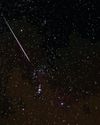يحاول ذهب - حر
How to make a planet
September 2025
|BBC Sky at Night Magazine
From stardust to rocky realms and gas giants, here's what it takes to build a world

To make a planet, first you'll need a massive, reasonably dense cloud of cold gas and dust.
Luckily, later generations of the cosmos have provided just that. These clouds, rich in hydrogen, helium and elements forged in earlier stars, are the raw ingredients for planets. In the case of Earth, this happened about 4.5 billion years ago. So if you're starting from scratch, you may want to clear your schedule for the next few aeons...
Next, you'll need something to give that cloud a cosmic nudge. A nearby supernova blast, a passing star or some other gravitational disturbance will do the trick. This triggers the cloud to begin collapsing under its own gravity. As it contracts, most of the mass falls towards the centre, forming a protostar. The rest flattens into a spinning protoplanetary disc. This is where the magic of planet building happens.
 As the protostar continues to feed on surrounding material, it grows hotter and denser. Eventually, its core becomes hot enough to ignite nuclear fusion, and - voilà! - a new star is born. But we're here for planets, not stars, so let's turn our attention to what's still swirling in the disc. This material isn't all the same temperature. The farther you go from the star, the cooler it gets. At certain distances, you'll hit what's called a snow line (or frost line), the point where gases like water, methane and ammonia are cold enough to condense into ice. As these ices start sticking to dust grains, they form larger and larger clumps. These sticky seeds are called planetesimals.
As the protostar continues to feed on surrounding material, it grows hotter and denser. Eventually, its core becomes hot enough to ignite nuclear fusion, and - voilà! - a new star is born. But we're here for planets, not stars, so let's turn our attention to what's still swirling in the disc. This material isn't all the same temperature. The farther you go from the star, the cooler it gets. At certain distances, you'll hit what's called a snow line (or frost line), the point where gases like water, methane and ammonia are cold enough to condense into ice. As these ices start sticking to dust grains, they form larger and larger clumps. These sticky seeds are called planetesimals. 
هذه القصة من طبعة September 2025 من BBC Sky at Night Magazine.
اشترك في Magzter GOLD للوصول إلى آلاف القصص المتميزة المنسقة، وأكثر من 9000 مجلة وصحيفة.
هل أنت مشترك بالفعل؟ تسجيل الدخول
المزيد من القصص من BBC Sky at Night Magazine

BBC Sky at Night Magazine
How to photograph the Geminids
Dramatic meteor photos aren't just down to luck. We show you how to bag one
3 mins
December 2025

BBC Sky at Night Magazine
10 Christmas crackers for your new telescope
So Santa brought you a telescope - what now? Stuart Atkinson sprinkles some cosmic sparkle, with 10 sights to see over one fabulous festive night - from glorious galaxies and planets to glittering star clusters
7 mins
December 2025

BBC Sky at Night Magazine
10 years of reusable rockets
Ben Evans charts the rise of multi-flight spacecraft, the tech revolution that's transforming our access to space
6 mins
December 2025

BBC Sky at Night Magazine
SKILLS FOR STARGAZERS
Take great photos of the Milky Way
3 mins
December 2025

BBC Sky at Night Magazine
Smart scopes: from backyard to big science
Home-based stargazers are helping scientists crack some of the Universe's big mysteries - and you can join them. Charlotte Daniels shows us how
6 mins
December 2025

BBC Sky at Night Magazine
FIELD OF VIEW
Forget Instagram – embrace the moment
2 mins
December 2025

BBC Sky at Night Magazine
Q&A WITH A PLANETARY LIFE EXPERT
Saturn's icy moon Enceladus boasts water, heat and organics. Now scientists have discovered it has complex chemistry too. Could it prove to be habitable?
3 mins
December 2025

BBC Sky at Night Magazine
INSIDE THE SKY AT NIGHT
When The Sky at Night joined Curious Cases for a special episode, George Dransfield was there to answer your burning questions. Here she dives deeper into her favourite
3 mins
December 2025

BBC Sky at Night Magazine
Students fix JWST's blurry vision
PhD researchers restore the telescope's ultra-precise imaging - without a spacewalk
1 min
December 2025

BBC Sky at Night Magazine
On a Mission
This is an inspiring tribute to the trailblazing women who shaped NASA's human spaceflight programmes.
1 mins
December 2025
Listen
Translate
Change font size

